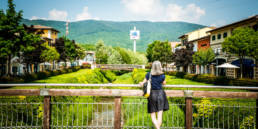I can’t remember what my comfort food was before I moved to Italy, but I think the main characteristics of comfort food have been the same my whole life long: warm, starchy, and mushy. I don’t know how this need developed – it was not from my mother, whose cooking is totally different from mine – but when I feel cold, sad, or sick, I need mush.
For me, the perfect warm mush is Minestrone. Now you’re going to tell me that this means “big soup” in Italian, and yes, for some people, minestrone is soup. But as I’ve learned, the recipe varies from season to place to stove, and for me, my minestrone is warm, starchy, and mushy. And also contains a big lot of fresh winter vegetables.

Minestrone or minestra is a vegetable soup that is present in every region of Italy, with variations as to what starch or protein you add. That is to say, you might add bread, farro, potato, pasta or rice; pancetta or beans. The vegetables that go in vary with the seasons, and the amount of liquid seems to vary in each household. Looking up what other people call “minestrone” to make sure my concept was aligned with that of the rest of the world, I read that some version of this dish was present in Ancient Roman times. Which prompted me to explore the historical aspects of this excellent Italian soup.
Every good writer has her limitations, and as I’ve said before, I am no food writer, and I sure ain’t no food historian either! But every good writer also has good writer friends, and when it comes to historical recipes, Emiko Davies, with her passion for the 19th-century Artusi, is the perfect person to consult. This pre-unification cookbook is a staple in Italian kitchens (but not in mine, where the Joy of Cooking still betrays my North-American roots), and Emiko has been blogging about a monthly Artusi recipe all year. I asked her what Artusi writes about Minestrone, and this is her reply:
This is one of the most memorable of Artusi’s recipes (no. 47). He tells the story that in 1855, the year of a cholera outbreak throughout Italy, he happened to be in Livorno. He goes to a trattoria where he asks what minestre are on the menu that day. “Minestrone”, is the reply. “Ben venga il minestrone,” says Artusi.
That night, he wakes with “una rivoluzione in corpo da fare spavento” (one of my favourite lines in the whole cookbook) and spends the rest of the night back and forth to the bathroom, cursing the Minestrone. In the morning, he takes the first train back to Florence where he immediately feels better and only then he finds out that Livorno was actually hit by the cholera outbreak and that the first victim was his own landlord. “Altro che minestrone!”
He then goes on with his preferred recipe for Minestrone… He doesn’t give any measurements, times or anything else, as I think he assumes everyone has their own recipe for minestrone or already knows it well enough.
This is one of the joys of Artusi – the story with the recipe – and also one of the joys of Italy, in which it is considered entirely normal to talk publicly about one’s digestive system.

I turn to my own bookshelf. In Tuscany, as Judy Witts Francini notes at the end of her recipe for minestrone in Secrets from my Tuscan Kitchen, “this soup is the base of the Tuscan bread soup “ribollita” when it is re-boiled with leftover bread.”
Pamela Sheldon Johns’ recipe for ribollita has four steps for four days. The first day involves making a soup, while subsequent steps make it re-boiled. I asked Pamela if this is what makes it real Cucina Povera: “It was the ingenuity of re-creation… first a vegetable soup, then those leftovers layered with dry bread, then finally ‘re-boiled,’ or reheated on top of the stove. Not a bit wasted and meals provided for days,” she explained to me.
I thought that ribollita had to contain cabbage and beans, and that real minestrone stared out this way too. But the recipe is not at all fixed; this, too, depends on its poor history. Pamela continues: “What we call ribollita today, in poorer times was a way to make a meal of whatever was at hand… a bit of beans, a few potatoes and foraged greens, some stale bread… In reality it was often just dried bread that was softened with a weak broth and a slice of onion to flavor it.” Her recipe suggests some categories of ingredients, but leaves proportions and final choices up to the cook. This is probably why her minestrone looks completely different from mine.

In a small and undated facsimile collection of Tuscan recipes received as a gift years ago from my well-wishing husband, I check out the instructions for minestra di verdura. Like Artusi, no proportions are given. In the case of minestrone, no ingredients are specified at all: “Pulite e tagliate grossolanamente ogni sorta di verdure che possiate avere.” (Wash and chop largely any kind of vegetable that you might have around.) Helpful.

Minestrone and I met thanks to my mother in law, who is originally from Taranto in Puglia, so don’t ask her about Tuscan cooking. Once she made me a minestra with all the ingredients I can eat. Artusi makes me feel it’s okay to mention that I have some digestive problems, so cabbage and legumes are out of the question. Her ingredients are similar to those listed in Judy’s book: potatoes, squash, zucchini, carrots, green beans, tomato, leek and onion. Judy also includes cabbage and garlic, and my MIL would put in beans and cavolo nero if it weren’t for me. To substitute the effect of chopped greens provided by cavolo nero, I have used bietole, which I don’t know how to say in English. When I make minestrone, I tend to use a rather high proportion of potato as I find more absorbing, starchy foods to be the most comforting.
At the end of this article you’d expect a recipe, right? Okay.
Take whatever winter greens you have around and boil them for an hour or more.
Note: My ingredients are in the photo above. I use canned, peeled whole tomatoes instead of fresh ones in the winter. Tomatoes add colour to the recipe and the acid in them helps neutralize the sweetness of the carrots and squash. There is also rosemary, parsley, oregano and salt, not pictured.
This is what my minestrone looks like. And I find it… comforting.


November Italy Blogging Roundtable
I got so into making this soup, I almost forgot that this is an Italy Blogging Roundtable post, which means I need to post links to other group members’ blogs on the topic of Comfort Food! Read ’em all, comment, and share!
- Jessica says “Comfort food is a cultural thing” and I cannot agree more!
- Gloria, our resident Tuscan, tells us about Tuscan comfort food
- Rebecca writes about Eating in the Comfort Zone and I wonder if that’s a clever reference to what I consider to be a very silly American diet book…
- Melanie’s article is entitled Comfort Me With Potatoes: A Tale of Two Tuber Dishes in Italy and I look forward to that (there are potatoes in my Minestrone too!)
Sign up to receive future blog posts by email
Alexandra Korey
Alexandra Korey aka @arttrav on social media, is a Florence-based writer and digital consultant. Her blog, ArtTrav has been online since 2004.
Related Posts
December 31, 2023
How sewing saved my sabbatical
April 30, 2022




